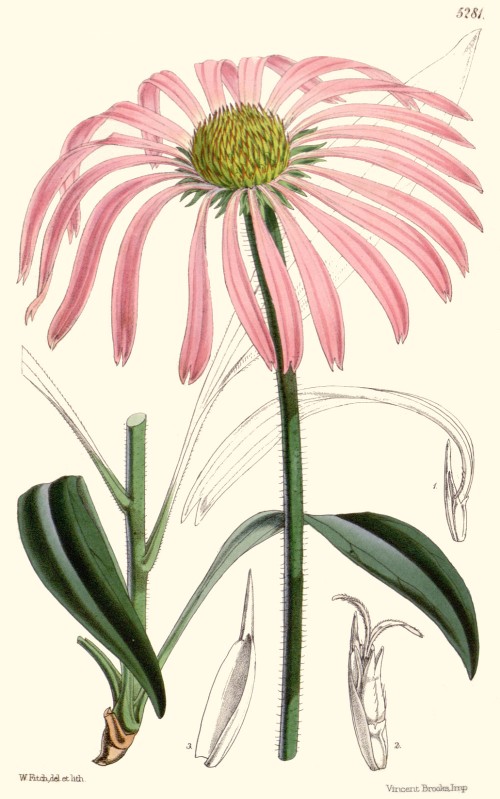Echinacea angustifolia DC. - syn. Echinacea pallida var. angustifolia (DC.) Cronq.; Brauneria angustifolia (DC.) A.Heller - Asteraceae
narrow-leaf coneflower, purple cone flower, black sampson, Schmalblättriger Sonnenhut, Schmalblättriger Igelkopf
Perennial herb, up to 70cm tall, native to central North America, cultivated in USA, Switzerland, Germany; moderately to densely hairy; stems mostly green to purplish; leaves elliptic to lanceolate, entire; paleae 9-14mm, tips purple, straight, sharp-pointed; ray corollas pink to purplish, up to 4cm long; disc corollas 5-7mm; cypselae often bicolored, tan proximally, dark brown banded distally, 4-5mm. http://www.efloras.org/florataxon.aspx?flora_id=1&taxon_id=242416463
A polysaccharidic fraction (EPF) obtained from Echinacea angustifolia roots inhibited carrageenan-induced paw oedema. „… furthermore, EPF, topically applied, inhibited mouse ear oedema induced by croton oil. EPF also reduced the leukocytic infiltration of the croton oil dermatitis, evaluated both as peroxidase activity and histologically. After topical application EPF appears to be slightly inferior in potency to indomethacin. The results suggest that the anti-inflammatory activity of E. angustifolia resides in its polysaccharidic content.“
[Anti‐inflammatory activity of a polysaccharidic fraction of Echinacea angustifolia., Tubaro, A., Tragni, E., Negro, P., Galli, C.L., Loggia, R.D., Journal of pharmacy and pharmacology, 39(7), 1987, 567-569]
The roots contain unsaturated alkylamides like undeca-2Z-en-8,10-diynoic acid isobutylamide, dodeca-2E-en-8,10-diynoic acid isobutylamide, undeca-2Z-en-8,10-diynoic acid 2-methylbutylamide, dodeca-2E-en-8,10-diynoic acid 2-methylbutylamide, hexadeca-2E,9Z-dien-12,14-diynoic acid isobutylamide and dodeca-2E,4Z,10Z-trien-8-ynoic acid isobutylamide.
[Alkamides from the roots of Echinacea angustifolia., Bauer, R., Remiger, P., Wagner, H., Phytochemistry, 28(2), 1989, 505-508]
Extracts of the roots are taken orally to support the therapy of colds and influenza.
[Medicinal Plants of the World. Ben-Erik Van Wyk and Michael Wink, Pretoria 2004, 129]
„It is generally thought that no single constituent or group of constituents is responsible for the activities of echinacea. Rather, several groups of constituents (the alkamides, caffeic acid derivatives, polysaccharides and alkenes (such as polyenes)) appear to contribute to activity. However, it has been reported that following
oral administration in man, alkamides are bioavailable, whereas caffeic acid derivatives are not and, therefore, cannot contribute to activity…“
[Echinacea species (Echinacea angustifolia (DC.) Hell., Echinacea pallida (Nutt.) Nutt., Echinacea purpurea (L.) Moench): a review of their chemistry, pharmacology and clinical properties., Barnes, J., Anderson, L.A., Gibbons, S., Phillipson, J.D., Journal of Pharmacy and Pharmacology, 57(8), 2005, 929-954]

Curtis’s Botanical Magazine, vol.87 [ser.3, vol.17], t.5281 (1861) [W.H.Fitch]
http://plantgenera.org/species.php?id_species=368717